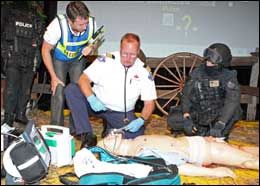By Maveric Vu
EMS1.com Staff
 |
| Courtesy photo Cory Brown, left, and Dannie Myers, right, intubate a mannequin during the simulation drill at the ACIP games in Australia. |
Being confronted with an unresponsive shooting victim, a handcuffed patient under the influence of drugs and an unconscious individual on the floor with a head injury is a challenge in itself.
Throw in a fourth patient — a man suffering from severe burns on his arm — and a heart monitor with the labels and meters all written in German, then it could be crisis time for some.
But not for fire captain/paramedic James Marugg and his team from San Diego’s Regional Cooperative Care Program. The group overcame all obstacles to win first place at an international EMS competition in Australia last month.
“I don’t know if it’s fully sunken in yet,” said Marugg, who is with San Miguel Consolidated Fire Protection District. “It was truly incredible.”
The team had advanced to the competition by winning the National Emergency Medical Services (EMS) Games in March in Baltimore, Md.
What makes the second triumph during last month’s event at the 2007 Asia Pacific International Conference all the more impressive is the fact they had to operate under Australian protocols.
 |
| Courtesy photo Teams from FDNY, left, San Diego, center, and British Columbia, right, receive their medals at the ACIP Games. |
Other winners included British Columbia coming in at second place and the FDNY, sponsored by Masimo Inc., at third. Trailing behind them were teams from Hong Kong and Australia.
Marugg’s team consisted of members Dannie Myers, a paramedic with American Medical Response, Cory Brown, a firefighter/paramedic with Bonita-Sunnyside Fire Protection District. They were headed by operations manager Travis Kusman from AMR.
The San Diego RCCP is a pilot program that unifies the region’s seven fire agencies and AMR under one umbrella.
“I’m immensely proud of my two other teammates,” Marugg said. “I’m proud of our accomplishment.”
The teams were evaluated based on their performance during a simulated multi-casualty incident.
Being the first from his team to arrive at the “scene,” Marugg assessed the situation — the shooting victim, the handcuffed patient and the unconscious individual on the floor.
“They set up the simulation and wanted to see us run it like a real call,” Marugg said. “So we handled just like it were a ‘run-of-the-mill’ kind of thing.”
 |
| Courtesy photo A member of the British Columbia team tends to a ‘patient’ during the 20-minute simulation drill. |
After five minutes, Myers and Brown were allowed to enter the scene. The three teammates had to decide who required treatment first and how much time they could devote to each patient based on the injury.
The team was judged on the use of proper treatment, interaction with each other, timeliness and other factors, Marugg said.
After 15 minutes into the call, the team had to deal with the addition of an unexpected fourth patient — the male suffering with the severe burn.
Shortly afterward, Marugg realized the heart monitor for the exercise, donated by a European manufacturer, was German. But none of it was enough to phase the team as they impressed the judges with their skills.
Marugg noted that all top three winning teams were from North America.
“We all showed automatic and mutual aid,” he said. “We function in a way that, if something does go down in a call, it doesn’t matter what uniform you wear — only that you are there to help.”
Lt. James “Bubba” Faller, with the FDNY, said he was proud to represent his department by securing third place.
“I was honored to be competing with the company that was there,” Faller said. “It seems that when we wore our FDNY shirts and people recognized us, their 9/11 memories returned.
“We were already winners as soon as we started our journey to Australia. The people we met are part of an experience that I will hold in my memory forever.”
Part of the challenge for the North American teams was finding the time to learn Australian EMS procedures.
“We had about 350 pages of protocol to get used to,” Marugg said. “There are a lot of meds that we don’t carry and a lot of procedures we don’t do.
“We definitely had to clear a lot of stuff off the shelf space in our brain to assimilate Australian protocol.”
Marugg said one of the most rewarding aspects of competing was learning about EMS in other parts of the world. He was even able to go on a ride-along with the Queensland Ambulance Service during the time of the conference.
“Australians are a very open and giving kind of people in general,” he said. “They carry that into their medical treatment and are very concerned with patient care and comfort. … These were good things to bring back to my department.”
As for more competitions in the future, Marugg said he is unsure if he will compete again soon. As winners, the team will be invited back to Australia in 2008. But for now, Marugg is just glad to resume his normal duties back in California.
“When you know you’re being judged, it brings you back in tune to when you first came out of paramedic or EMT school,” he said. “Your concentration is not just on the basics, but how everything interacts with each other and how that affects patient care. It really renews the enthusiasm you have for your job.”











